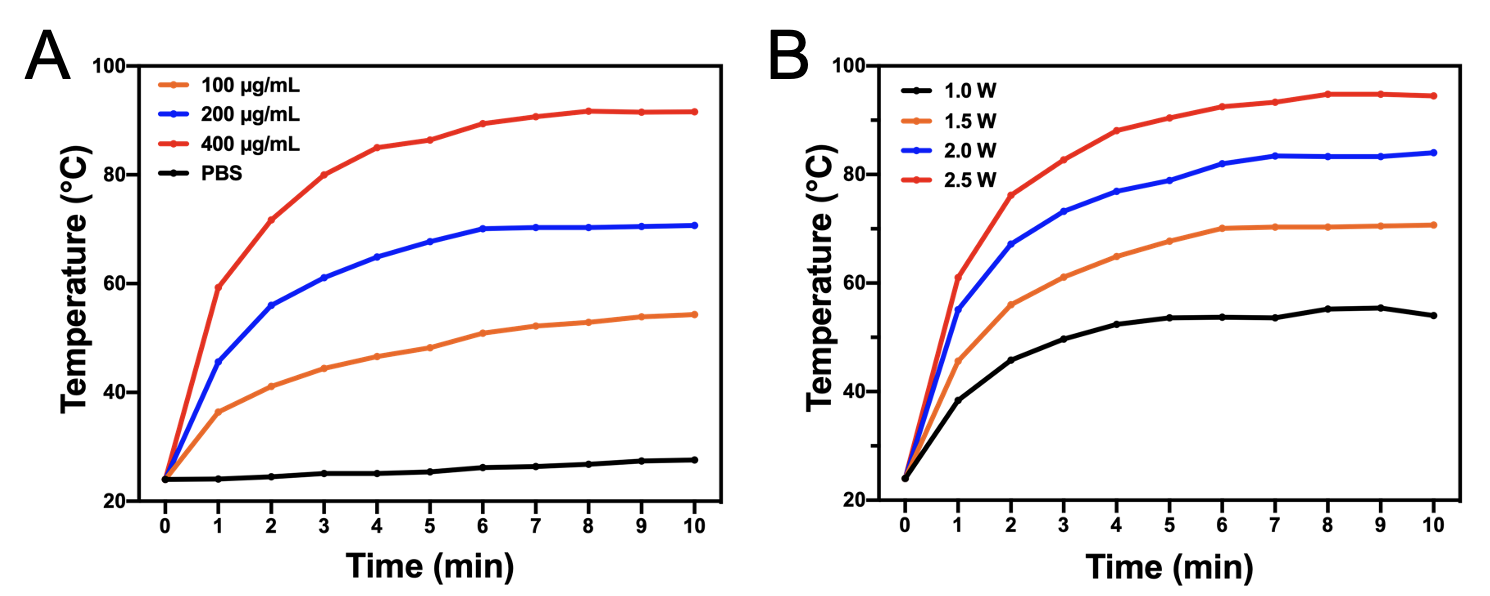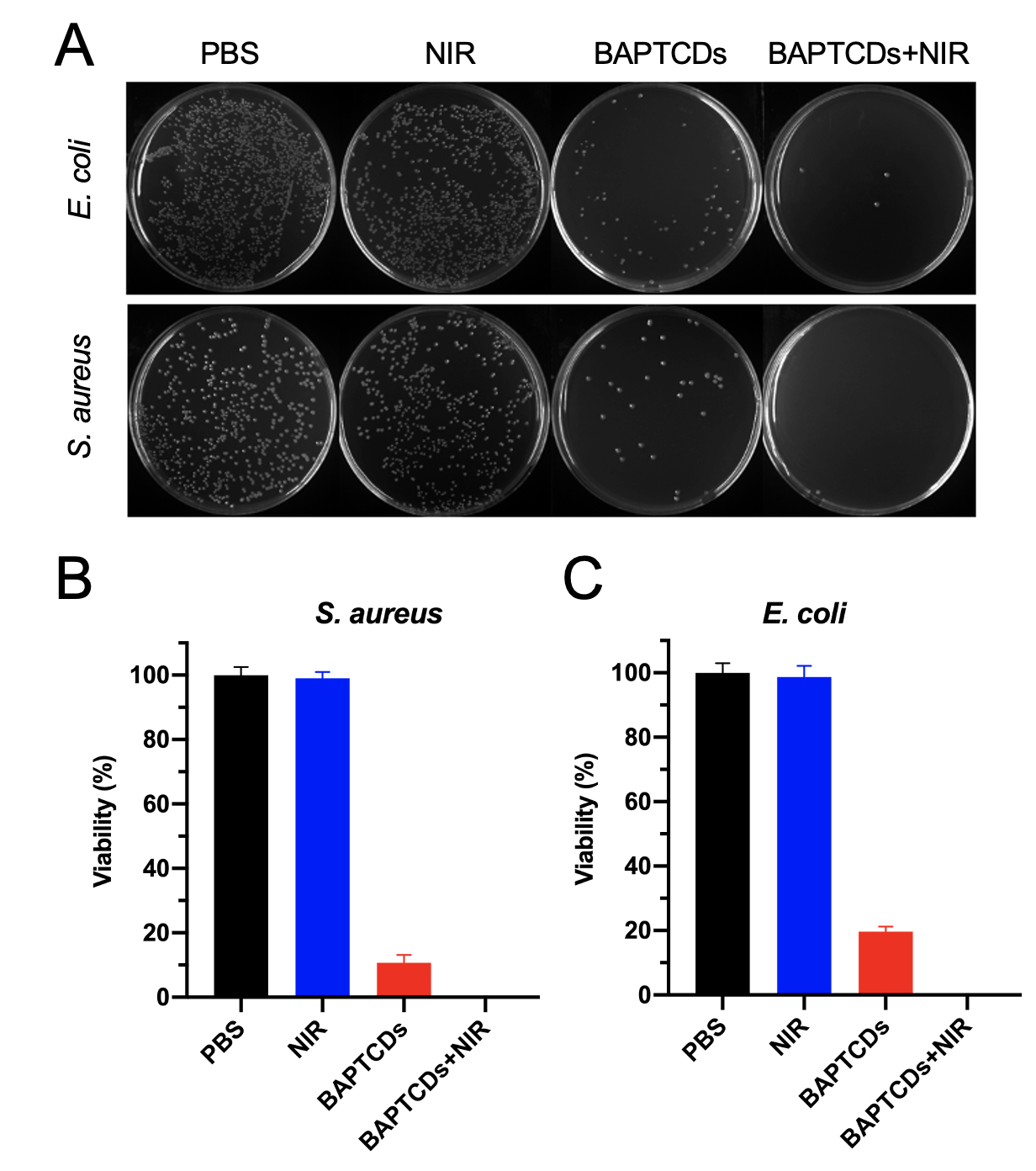Bacterial infections claim approximately 17 million victims worldwide each year. Usage of antibiotics help fight bacterial infection but abuse of antibiotics have resulted in emergence and widespread prevalence of "superbacteria", which made the treatment of infectious diseases a worldwide problem again.
Photothermal technology (PTT) has received widespread attention for the treatment of bacterial infections. Recently, researchers from Suzhou Institute of Biomedical Engineering and Technology (SIBET) of the Chinese Academy of Sciences, developed a bacteria-affinitive photothermal carbon dots (BAPTCDs).
BAPTCDs is synthesized from o-phenylenediamine and D-glutamic acid (D-Glu) by a solvothermal method. They can specifically bind bacteria and rapidly heat up with laser irradiation to destroy bacterial cell walls and kill bacteria.

Figure 1. Schematic illustration of synthesis of the BAPTCDs and the mechanism of bacteria targeting and photothermal ablation of BAPTCDs upon laser irradiation. (Image by SIBET)
"PTT uses targeted recognition to accumulate photothermal materials near the target tissue and convert light energy into thermal energy via an external light source, usually near-infrared light, to kill bacteria,” said SONG Yizhi, one of the leading researchers of the study.
However, for specific identification and killing of bacteria, it is very important to develop a specific photothermal bactericidal material.
"MurD ligase is a very important enzyme in bacterial cell wall synthesis. It catalyzes the intermediate with D-Glu,” said SONG. This enzyme only exists in prokaryotes, and only prokaryotes can utilize D-type amino acids, so D-Glu derivatives are often used to develop antibacterial agents to kill bacteria by inhibiting cell wall synthesis.
BAPTCDs have an excellent photothermal effect, as shown in Figure 2, the temperature of the BAPTCD solution with different concentrations rapidly increased and stabilized within 10 mins. The maximum temperature of BAPTCDs increased with the increase of material concentration and laser power.
Results of the experiments showed that 80.33% of E. coli (ATCC 700926) and 89.27% of S. aureus (ATCC 29213) were killed by BAPTCDs without NIR, which may contribute to its inhibition of the MurD protein. When irradiated with NIR (808 nm, 1.5 W/cm2), only 3.67% of E. coli survived and all of the S. aureus were killed due to the rapidly rising temperature.
"Combined with the advantages of high stability, high fluorescence quantum efficiency, good water solubility and non-toxicity of the carbon dots itself, the BAPTCDs has a very good application prospect,” said DONG Wenfei, another leading researcher of the study from SIBET.

Figure 2. Photothermal property of BAPTCDs. (A) Temperature change of BAPTCDs aqueous with different concentrations upon 10 min of 808 nm laser irradiation (power density = 1.5 W/cm2). (B) BAPTCDs at the concentration of 200 μg/ml with a series of power densities of 808 nm laser irradiation. (Image by SIBET)
Figure 3. (A) Photographic images of the colonies of E. coli ATCC 700926 and S. aureus ATCC 29213 treated by PBS, BAPTCDs, BAPTCDs with NIR (power density = 1.5 W/cm2), and NIR only by a standard plate count method. The concentration of BAPTCDs was 200 μg/ml. Bacterial viability of S. aureus ATCC 29213 (B) and E. coli ATCC 700926 (C) were obtained by the colony-forming count method. (Error bars represent the standard deviation of at least three independent experiments). (Image by SIBET)
The research results entitled “Design, synthesis, and application of carbon dots with synergistic antibacterial activity” were published in the Frontiers in Bioengineering and Biotechnology (IF: 5.82).
Dr. QIE Xingwang is the first author of the paper, and Prof. SONG Yizhi and Prof. DONG Wenfei are the co-corresponding authors. The research was supported by the National Key R&D Program of China, Scientific Instrument Developing Project of the Chinese Academy of Sciences, etc.
Contact
XIAO Xintong
Suzhou Institute of Biomedical Engineering and Technology, Chinese Academy of Sciences (http://www.sibet.cas.cn/)
Phone: 86-512-69588013
E-mail: xiaoxt@sibet.ac.cn